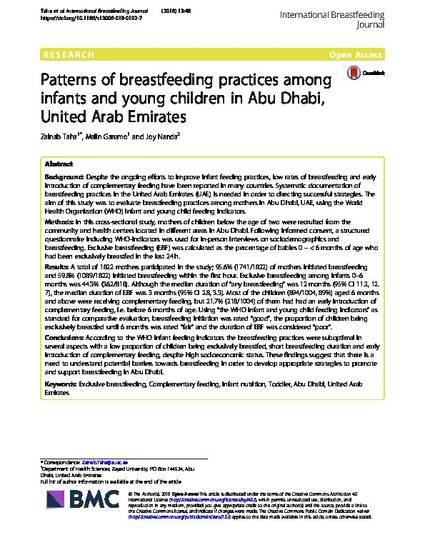
© 2018 The Author(s). Background: Despite the ongoing efforts to improve infant feeding practices, low rates of breastfeeding and early introduction of complementary feeding have been reported in many countries. Systematic documentation of breastfeeding practices in the United Arab Emirates (UAE) is needed in order to directing successful strategies. The aim of this study was to evaluate breastfeeding practices among mothers in Abu Dhabi, UAE, using the World Health Organization (WHO) infant and young child feeding indicators. Methods: In this cross-sectional study, mothers of children below the age of two were recruited from the community and health centers located in different areas in Abu Dhabi. Following informed consent, a structured questionnaire including WHO-indicators was used for in-person interviews on sociodemographics and breastfeeding. Exclusive breastfeeding (EBF) was calculated as the percentage of babies 0 - study; 95.6% (1741/1822) of mothers initiated breastfeeding and 59.8% (1089/1822) initiated breastfeeding within the first hour. Exclusive breastfeeding among infants 0-6months was 44.3% (362/818). Although the median duration of "any breastfeeding" was 12months (95% CI 11.2, 12.7), the median duration of EBF was 3 months (95% CI 2.8, 3.3). Most of the children (894/1004, 89%) aged 6 months and above were receiving complementary feeding, but 21.7% (218/1004) of them had had an early introduction of complementary feeding, i.e. before 6 months of age. Using "the WHO infant and young child feeding indicators" as standard for comparative evaluation, breastfeeding initiation was rated "good", the proportion of children being exclusively breastfed until 6 months was rated "fair" and the duration of EBF was considered "poor". Conclusions: According to the WHO infant feeding indicators the breastfeeding practices were suboptimal in several aspects with a low proportion of children being exclusively breastfed, short breastfeeding duration and early introduction of complementary feeding, despite high socioeconomic status. These findings suggest that there is a need to understand potential barriers towards breastfeeding in order to develop appropriate strategies to promote and support breastfeeding in Abu Dhabi.
- Abu Dhabi,
- Complementary feeding,
- Exclusive breastfeeding,
- Infant nutrition,
- Toddler,
- United Arab Emirates
Available at: http://works.bepress.com/zainab-taha/1/